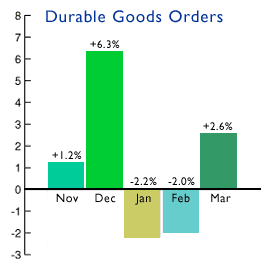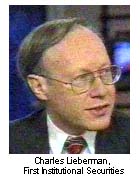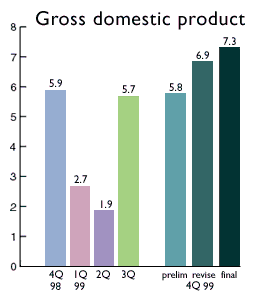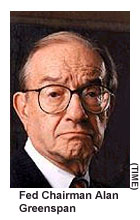|
Durable orders surge
|
 |
April 26, 2000: 8:50 a.m. ET
March orders jump 2.6%, the first time in three months
By Staff Writer M. Corey Goldman
|
NEW YORK (CNNfn) - Orders for durable goods produced by U.S. factories rose for the first time in three months in March, the government reported Wednesday, a pace that tops forecasts and reflects a surge in electronics and electronic components orders. Excluding transportation goods, orders jumped even higher.
 According to the Commerce Department, orders for durable goods -- or long-lasting goods such as ovens and computers -- jumped 2.6 percent. The result tops the 2 percent gain predicted by analysts for March and the 2 percent drop in February. Excluding transportation goods, which tend to be volatile from month to month, orders rose 2.8 percent after a revised 0.5 percent increase a month earlier. Excluding defense goods, orders rose 3.7 percent. According to the Commerce Department, orders for durable goods -- or long-lasting goods such as ovens and computers -- jumped 2.6 percent. The result tops the 2 percent gain predicted by analysts for March and the 2 percent drop in February. Excluding transportation goods, which tend to be volatile from month to month, orders rose 2.8 percent after a revised 0.5 percent increase a month earlier. Excluding defense goods, orders rose 3.7 percent.
The monthly gain was the first since December. Although considered volatile, some economists took the increase as a sign that demand for U.S.-made goods at home and abroad remains robust, despite five quarter-point interest rate increases by the Federal Reserve in the past 10 months aimed at curtailing spending. That means more rate increases will likely be in store as the Fed attempts to slow the economy down, analysts said.
"This is a very strong report," Charles Lieberman, chief economist with First Institutional Securities, told CNNfn's Before Hours. "The economy clearly is growing too strong and it's not going to stop on a dime, which is not very convenient to suit the Fed's needs and to meet the stock market's needs."
High-tech production
U.S. factories have been stepping up production in response to surging consumer demand, an enormous factor behind the resilient economy now into its 10th year of uninterrupted expansion, which the Fed is trying to tame. Consumer spending accounts for roughly two-thirds of the economy's output; personal spending rose at a 1 percent pace in February.
 On top of that, rebounding economic growth abroad, particularly in the Far East, has spurred renewed demand for U.S. products, particularly goods that can be used in the production of such items as computers, electronics and other consumer-oriented merchandise. Orders for electronic goods jumped 9.7 percent in the month, the biggest increase since November. On top of that, rebounding economic growth abroad, particularly in the Far East, has spurred renewed demand for U.S. products, particularly goods that can be used in the production of such items as computers, electronics and other consumer-oriented merchandise. Orders for electronic goods jumped 9.7 percent in the month, the biggest increase since November.
And with no indication that consumer spending at home is slowing or that demand overseas for U.S. goods is waning, orders are expected to keep flowing in, Lieberman said, prompting more demand for workers, placing more pressure on companies to pay higher salaries and spurring faster growth, something the Fed does not want to see. (310KB WAV) (310KB AIFF)
Indeed, unfilled orders for durable goods rose 1.1 percent in March after rising 0.6 percent in February. Shipments of durable goods rose 1.5 percent after falling 1.4 percent, while orders for non-defense capital goods -- a category the government uses to calculate companies' investment plans -- rose 2 percent after falling 9.4 percent.
Aircraft orders jump
Orders for transportation-related goods gained 1.8 percent. Within that, orders for commercial aircraft surged more than 10 percent, a reflection of a surge in orders for Boeing Co. (BA: Research, Estimates) in the wake of a 40-day strike that ended in mid-March. The Seattle-based company said orders for its jet planes surged to 111 in March from only 11 in February.
 Non-defense capital goods, excluding aircraft, rose 1 percent after falling 6.6 percent in February. Orders for defense capital goods fell 30.6 percent in March after declining 4.1 percent in February. Partly offsetting the overall increase in orders was a 2.1 percent drop in orders for industrial machinery and equipment. Non-defense capital goods, excluding aircraft, rose 1 percent after falling 6.6 percent in February. Orders for defense capital goods fell 30.6 percent in March after declining 4.1 percent in February. Partly offsetting the overall increase in orders was a 2.1 percent drop in orders for industrial machinery and equipment.
"The ongoing expansion of the factory sector is being fueled by strong domestic demand and improving international economic conditions," said Steven Wood, an economist with Banc of America Securities. More importantly, "it is frustrating the FOMC's attempts to slow overall economic growth."
The Commerce Department will release its preliminary estimate on first-quarter economic growth Thursday at 8:30 a.m. ET. Analysts polled by Briefing.com estimate the economy grew at a 6 percent pace in the first three months of the year, slightly below the 7.3 percent pace registered in the fourth quarter, though well above what most economists and Fed officials deem a "comfortable" pace for non-inflationary growth.
But there's still productivity...
Also, the Labor Department will report Thursday its quarterly tally on employment costs for companies. Analysts estimate costs rose 0.9 percent in the first quarter after gaining 1 percent in the final three months of 1999. Employment costs are crucial because higher employee salaries and benefits can prompt firms to raise the prices they charge for goods and services, spurring inflation.
 To be sure, analysts and economists will be watching the so-called ECI report very closely to see if companies are paying more to produce goods. What's kept them from raising costs so far has been strong gains in worker productivity, where advances in technology -- everything from smaller and faster computer chips to wireless telephones -- has kept costs down. To be sure, analysts and economists will be watching the so-called ECI report very closely to see if companies are paying more to produce goods. What's kept them from raising costs so far has been strong gains in worker productivity, where advances in technology -- everything from smaller and faster computer chips to wireless telephones -- has kept costs down.
Fed Chairman Alan Greenspan has praised productivity as one of the saving graces of the record economic expansion. Without it, he has suggested, prices would likely have to rise significantly to allow companies to continue producing profits in the face of rising costs. At the same time, the Fed Chief has cautioned that too much productivity can be a bad thing -- by keeping prices low and encouraging Americans to spend more, thereby fueling growth.
"It works both ways," said Mike Moran, chief economist with Daiwa Securities. "Productivity is certainly providing resistance to inflation at this time, but at the same time it is fueling demand in the economy. We see it pushing up consumer demand very much because of its effect on stock prices," he said. "No matter what, growth needs to slow down a bit for all these elements to work together properly." 
|
|
|
|
|
 |

|

